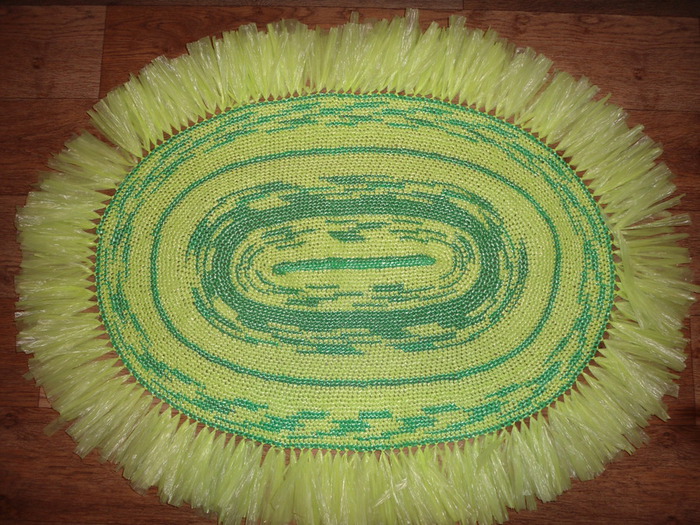How to make a rug from plastic bags. Weaving from bags.
Surely many people have old plastic bags at home. We all need them for something. What if the packages just lie there like dead weight? In this case, there is a great opportunity to use them profitably, and at the same time there will be something to do in your free time.
You can find a lot of interesting things from the world of crafts on the Internet. One of the areas of needlework is knitting rugs. In our case, this is not just knitting, but weaving rugs for the bath, toilet, hallway, and balcony.
Rugs made from trash bags
First of all, before you start making rugs, need to prepare yarn. You can use both old and new packages. To make yarn from garbage bags, certain rules must be followed:
- Plastic bags come in different densities. It is most convenient to work with a material that is less dense.
- To make strands of yarn, bags are cut into strips. The lower the density, the wider the strip can be: the usual width is 3 centimeters. High density garbage bags can be cut into strips 1-1.5 centimeters wide.
- Before you start knitting, you should make a test piece (sample) to know how comfortable it is to work with yarn.
- It is advisable for beginning knitters to start knitting from bags with a volume of 50 liters or less. Over time, when you have more skills, you can switch to plastic bags of larger volume. This is due to the fact that larger displacement invariably comes with increased density.
- Very thin material cannot be used either, since the knitted product turns out ugly - it does not hold its shape.
Making yarn from trash bags
Now let's get started to creating the yarn itself.
An important point in knitting a rug with your own hands is that the bags intended for creating yarn should not only be soft, but also matte in color. Crochet products from bags, so the thickness of the thread must correspond to its number.
Master class on crocheting a rug
For knitting usually hook size 6 or 8 is used. For those who know how to knit, this task will not be difficult:
- the base is made from air loops;
- the resulting chain is tied with single crochets;
- the shape of the product to the taste of the knitter.
To understand the knitting pattern from garbage bags, consider two examples of a master class on making a rug. Then everyone chooses the appropriate option for themselves.
Option #1
 Knitting a rug from bags begins from a set of 6 air loops. We collect the cast-on loops into a circle and continue knitting in the round in this way:
Knitting a rug from bags begins from a set of 6 air loops. We collect the cast-on loops into a circle and continue knitting in the round in this way:
- The first stitch to be knitted is a single crochet and 1 chain stitch;
- then 3 columns;
- after 3 tbsp. 1 air loop is knitted again.
Single crochets are crocheted using the front loop of the resulting braid.
You need to cast on 60 loops in a circle, after which you can begin the next row:
- first we crochet 10 single crochets and 8 air loops;
- then there are 8 single crochets over the air loops;
- repeat what we started: 10 single crochets and air loops.
Thus, we knit the entire circle. The circle should look like a marine steering wheel with six arms.
If this is the case, then 2-3 loops are crocheted together in front of each ray. On top part 1 air loop is added to the beam to give a rounding.
The result of knitting will be a circle depicting a flower. This is how rugs are knitted from bags in the shape of a flower or a circle. Any knitter can do this with her own hands.
Option No. 2
This version of the master class is different in that individual fragments are first knitted, which are then joined together. Another difference is the square shape of the product.
Diagram of this rug made from bags is this:

The end of the row will be like this: 3 stitches and 1 double crochet, 3 chain stitches, 2 double crochets connected by 1 single crochet, we close by connecting the beginning of the row to the end.
The 3rd, 4th and 5th rows are also knitted. The result is a square.
Finished fragments of cellophane yarn are connected with thread. To do this, the edges of two self-made squares are aligned and crocheted together using single crochets.
Squares by color or in a checkerboard pattern are connected into strips of the required length. Then the strips are connected to each other according to the principle of connecting squares.
Ready-made mat from bags tied around the perimeter:
- the first two rows are knitted in single crochets;
- knitting 3 rows - this is 3 double crochets, knitted through a loop of 2 rows, one loop is skipped;
- the connecting stitch is knitted, and after that the method of knitting row 3 is repeated. This is how it is done required quantity rows.
Requirements for hand-knitted rugs
 Everyone who makes something for themselves tries to make the product work high quality and durable. The same goes for rugs made from trash bags.
Everyone who makes something for themselves tries to make the product work high quality and durable. The same goes for rugs made from trash bags.
- polyethylene mats must be durable;
- if the product is intended to be used as a bedding in front of the front door, then it must retain all the dirt;
- all types of rugs should not collect moisture and dust;
- the product should be such that it can be easily washed, not to mention just shaken out;
- environmental safety- an important point, and therefore bags with a smell cannot be used;
- price is important point, since it was originally intended to be a low-budget product;
- the thing should be beautiful, it all depends on the imagination and skill of the knitter, that is, on her own.
What to do if you want to diversify the design a little hygienic room without spending a lot of money on it? Some may say that the situation is hopeless, but it is not. With a little imagination, you can make cute rugs with your own hands from multi-colored plastic bags. They will add a touch of elegance to the bathroom and at the same time serve their intended purpose.
Is the game worth the candle?
Why waste time making rugs that don't inspire confidence at first glance? To dispel doubts, it is worth giving some arguments in favor of this choice:
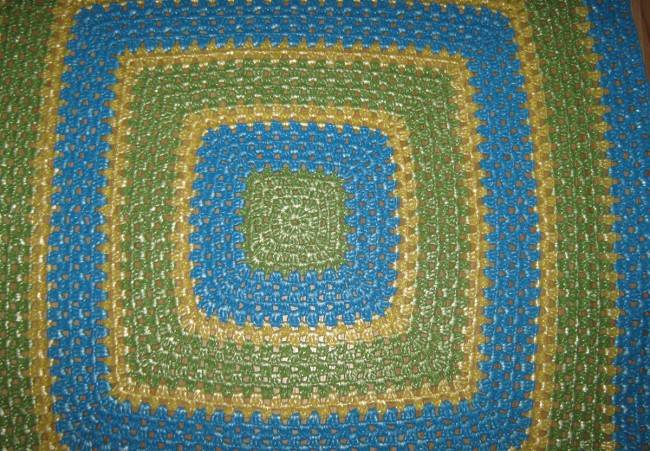
Knitted carpet
- Such products do not absorb moisture, so dampness in the room when using them is excluded.
- They are very easy to wash and clean, and to dry polyethylene mats, you just need to hang them on the balcony.
- They are warm and soft to the touch. You can put them in front of the bathtub and leave it without fear of slipping.
- These rugs are easy to care for. Apply a soap solution to them, rub it with something like a washcloth and rinse with a stream of water.
- And of course, the decorative component. You can make original rugs with your own hands to decorate your room.
Needless to say, crocheting will allow you to pass the time watching your favorite movie.
Among other things, a rug made from old plastic bags can be placed not only in the bathroom. It will also fit in the toilet or front door. And when it becomes unusable, you won’t mind throwing it away and replacing it with a new one.
In a word, such rugs are not only in a practical way decoration, but also when the right approach can bring a little aesthetics to the room. At the same time, making them is quite simple. You just need to stock up on materials, turn on your favorite movie and start making a rug.
But first, let's talk about how to do it correctly and how much material is needed.
Two ways to weave rugs
Pom pom method
In this knitting option, small balls are made from plastic bags and tied together. The result is a pretty cute rug. Such an instance will not only fulfill its intended purpose, but will also slightly transform the room. Such products look interesting in their own way due to the volume of the knitting.
To prepare the pompoms, you need to cut the bags into strips about 1 cm wide. Then one strip is taken, wound onto a small template and tied in the middle with a strong thread. The edges are then trimmed and the resulting product is fluffed up like a pompom.
To make a rug, you will need at least 30 polyethylene balls. When you have prepared the pompoms in the right amount, you need to sew them onto a special mesh for carpets, which is sold in stores. Or you can make it yourself from scrap materials.
Method two - crochet

Crochet
Now let's talk about the second method of making rugs from bags with your own hands. In addition to being easy to care for, they can also be made with a variety of patterns. To work, you will have to cut the bags into strips 2.5–3 cm wide and then crochet them.
For those who decided to make such a rug with their own hands for the first time, this process will seem long and a little tedious. But once you get the hang of it, you can knit a uniquely beautiful rug in just a couple of hours. The patterns can be used standard or for openwork weaving. If this is difficult for you, then you can knit one continuous fabric.
By the way, you can knit not only rugs from plastic bags, but also slippers, bags and even decorative vases.
Knitting a round rug
This is the easiest method, and beginners should start with it. Don't experiment! After all, to begin with, the main thing is to learn how to knit correctly, so use stripes of different colors. Let it be a kind of avant-garde of color.
The diameter of the rug that we will make is 50 cm with the width of each woven strip being 5 cm.
Let's start knitting
Knitting a round rug is not that difficult. Main- add loops in time, otherwise the product will curl and take the shape of a concave bowl.
So let's get started:
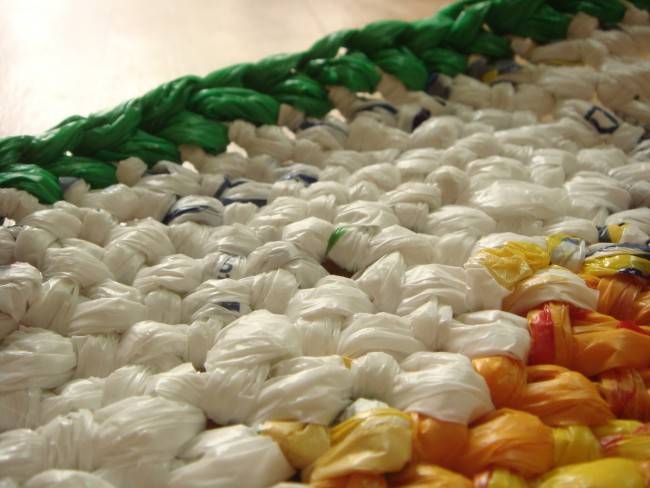
Type of mating
- For example, let's make the center of the rug red. To do this, take one strip and knit 5 air loops from it, which are closed into one ring. Then we knit another loop and unfold the knitting in the opposite side. We make all single crochets in each of the 5 loops of the previous row. At the same time, we thread two additional stripes into the 2nd and 4th loops. Having knitted to the end of the turning loop, we again unfold the weaving in reverse side, thereby closing the circle.
- Next will be the yellow row. Everything is knitted in exactly the same order as the middle, in small stitches. Only here there is a little decorative trick. In order for the circles to increase from the center to the sides, at equal weaving intervals it is necessary to add 5 or 6 loops, knitting 2 single crochets.
- After the yellow stripe, start knitting, for example, green rows. It will turn out to be a kind of traffic light. The width of this insert should also be 5 cm, and it is knitted similarly to the previous ones.
The entire mat is made in this way. That is, every 5 cm you weave stripes of a different color. Now you can knit a round rug from polyethylene strips with your own hands. Place it in the bathroom, and its diversity will please the eye.
Variety of crafts
You can find a large number on the Internet different ways how to make beautiful accessories from old waste materials with your own hands, women's handbags and much more.
Garbage bags, old plastic bottles, CDs - from all this, with the right approach, you can make various educational toys for children and original crafts.
In addition, you can involve your child in the process and believe me, he will gladly take part in this new activity for him.
Women's handbag made of plastic bags

Handbag
This accessory is considered the most popular among home needlewomen after knitting bath mats. But unlike the latter, here you will first have to prepare the so-called yarn.
It’s quite simple to make, and the process of knitting a handbag itself is not too complicated. Handbags knitted from waste material, turn out to be quite cute, fashionable and completely free.
What materials to choose for “yarn”
You, of course, know that garbage bags come in different forms. The first parameter indicated by the manufacturer is the total volume. Typically it is 20, 25, 30, 60 and 120 liters. The second parameter is the density of the material, that is, polyethylene. Packages with a higher percentage of density are a little rougher to the touch.
Here you need to adhere to certain recommendations - the higher the density, the thinner the strips for “yarn” should be cut. With experience, everything will come, and you will learn how to choose the right hooks for knitting materials of different densities, and for starters, a medium-density bag will do.
If this is your first time taking up this task, then first try to knit a small sample of fabric so that you know approximately what you need to do later.
We also advise beginner knitters to take yarn bags with a less dense structure and a capacity of no more than 50 liters. The “yarn” from them will be softer, and knitting will be easier. In addition, pay attention to bags with a minimum density, because products made from them hold their shape very poorly.
We prepare high-quality yarn for crafts
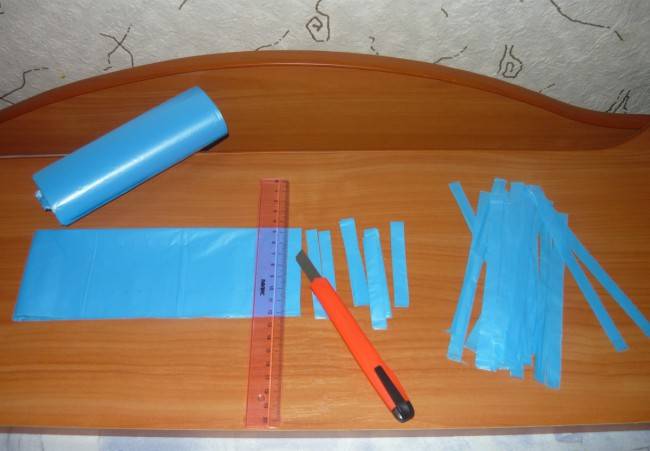
Cutting strips
We figured out which bags to choose for making bags or rugs with your own hands. Now let's look at how to prepare the required amount of “yarn”:
- To form knitting threads, you need to cut garbage bags into even strips in accordance with the hook number - best option 4–5 cm.
Try to keep the strips even and the same width, then when knitting the surface of the rug will be uniform in thickness.
- To speed up cutting, place several bags in a stack on the table and cut off the strips with a stationery knife along the ruler attached to them.
- Once you have everything cut, straighten one strip and you should have a ring.
From such blanks you will form yarn. There are two ways to do this. Let's look at both options.
Option one
In the first case, all the elements are connected immediately into a ball.
To do this, take one ring, insert another into it, connecting the two edges together, and pull the next strip through them. In this way, all the rings cut from the bags are tied together.
The resulting thread is wound into a ball. In this option, the “yarn” will be thicker and the rug will be more fluffy. But the length of the thread will be slightly shorter.
Option two

Waterproof carpet
Here the length of the yarn will be longer, but the thread itself will be thinner. Which method to choose is up to you.
The principle of preparing knitting thread is as follows. One ring is taken and another is threaded through it. A loop is formed from the second strip by passing one ring through the other, tightening one edge moderately. All other rings are connected in the same way.
In this way, you can prepare yarn of various lengths and individual colors in balls. Everything is limited only by your imagination and desire to make an original rug.
Carpets made from old T-shirts
These hand-made rugs will also look good in the bathroom. To knit them you will need several old cotton T-shirts of different colors, thread and a strong piece of fabric for the base.
The process of knitting rugs from old things is simply simple:
- First, we cut the T-shirts into equal strips 2–3 cm wide for yarn.
- Gently stretch each one so that the edges curl into tubes.
- Cut them 10–15 centimeters long.
- After this, you need to measure the floor in front of the bathroom and make an allowance on each side of 1–2 cm - to make a base for the rug.
- We lay the tubes on it in even or, on the contrary, chaotic rows and carefully sew each of them in the middle.
- All stripes are stitched in this way.
If you get a little creative and arrange all the stripes differently, you will end up with an original shaggy rug.
- Once you have attached all the pieces, fold the edges of the rug and stitch them.
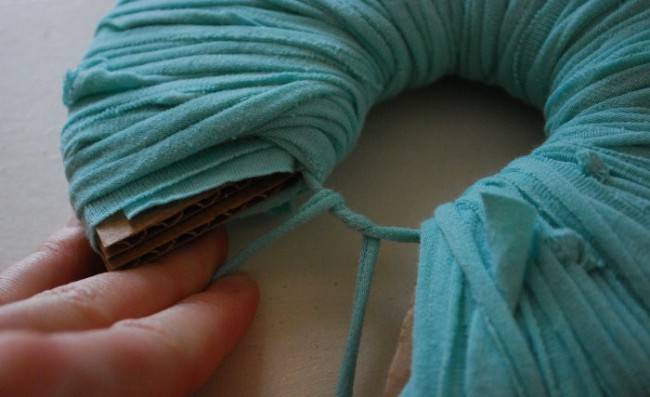
Winding a T-shirt on a cardboard base
That's all. A beautiful and unique bath mat is ready. What distinguishes it from the option with garbage bags is that such a product will have to be constantly dried after acceptance. water procedures. But this in no way reduces the feasibility of making such rugs with your own hands.
Conclusion
If you need to make an original rug for a children's room, try to use the original material bright colors. If you use the preliminary selection method and practice a little, you will be able to create simple patterns from stripes of different colors. So all subsequent rugs will be different from each other.
Publications on the topic
 Ruslan Vasiliev
Ruslan Vasiliev
I invite you to join the acquaintance))
Photo and text by the author.

I describe everything in detail, I think no questions should arise. But, if anything happens, I will certainly answer))
Let me make a reservation right away - I don’t know how to knit!! Don’t judge strictly) But I know that I’m knitting WRONG! Although, for the sake of experiment, I tried it correctly - it’s really easier to knit, but some knitting comes out painfully flat... and if done incorrectly, it turns out to be fuller)
So, we take a bunch of bags, carefully fold each one several times... 
To speed up the cutting process, I stack them in several pieces 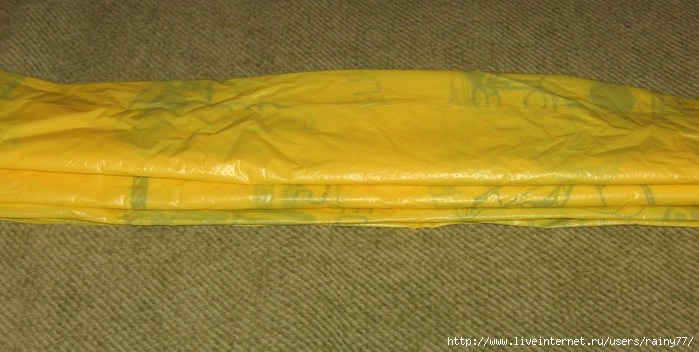
Let's proceed directly to cutting. We cut into not very narrow strips so as not to tear in the process.
Which ones exactly - everyone will ultimately decide for themselves individually) 
When you’ve already cut quite a lot... and you’re tired of it)) 
Let's start straightening them out...
This matter is also quite boring, so you should seriously think about involving someone in this process))
I always have an assistant at work and at home) At home, a specially trained Bunny helps)
Now she will show us what will ultimately come out of this.. 
The end result should be rings like this... 
Lots of rings!!! heaps of rings!!! 
Now, in turn, we connect them together. We don’t tighten it too much - firstly, so as not to tear it, and secondly, it will be more convenient to untie it later! This will come in handy if the rug is colored. 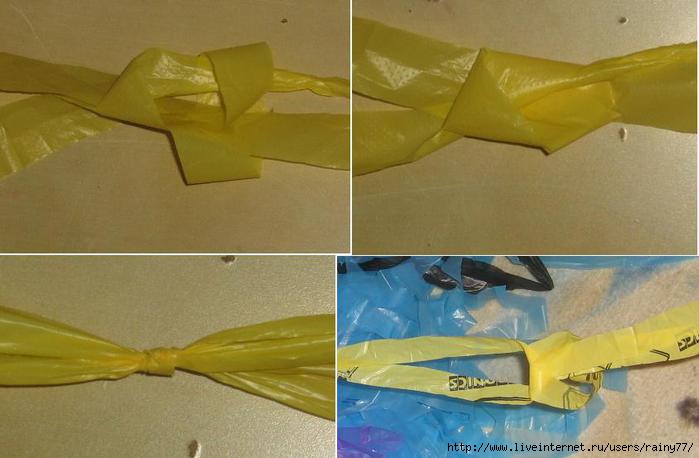
The result of this stage - we get these koloboks) 
Let's start knitting. This is my - the same - wrong) 
We have a loop on the hook, at the same time we insert the hook into the hole and take out another loop, then we pull the thread through both of these loops - we get one loop again. We repeat this countless times) 

And now - where to start.
I can do it without any strings at the tip)) Since the thread is a ring, we very simply tie it on a hook - just like we tied the bags before. And not very tight. We have to pull a thread through it. 
Now, as mentioned above, we pull the thread through it, through the resulting loop again, until a chain is formed. There is no need to make a long one, unless, of course, you want a rug with a hole in the middle)
After this, insert the hook into the very first hole and pull the thread through it, thus obtaining a closed base 
Then, insert the hook into the nearest hole, pull out the thread - two are formed on the hook, and pull the thread through them, forming one again. 
But I already wrote about this above, it is worth mentioning this nuance - at the beginning of knitting it is worth poking into each hole twice, and then, as knitting progresses, it is worth knitting two loops in some holes, thus adding them. Otherwise, you will end up with a hat - which is also sometimes not bad and on time))
When you start knitting, you will understand what I mean)
Don't knit tightly.
If in the process of further knitting the rug still turns inward a little, it’s okay, the polyethylene material is grateful, it stretches very well) But you shouldn’t abuse it! Just as you should not overuse the addition of loops, the rug will turn out wavy.
So, we already have a small circle... 
Now, finally, how to start a new color. It’s simple - our threads are connected to each other, we untie one of the knots and tie a thread of a different color, we knit further as if nothing had happened)) 

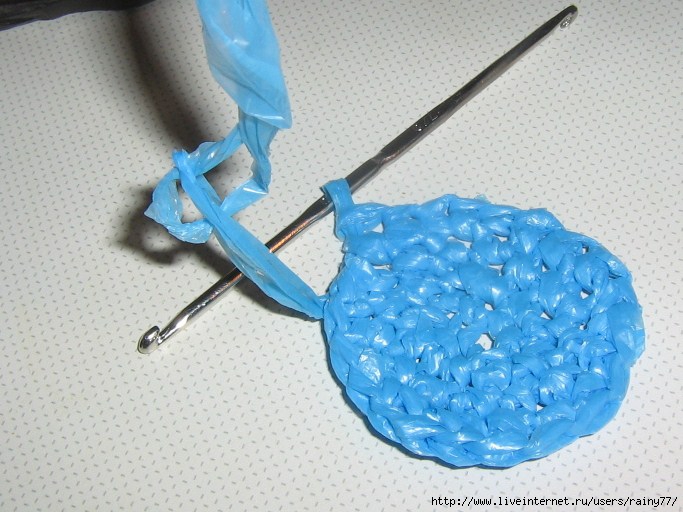



![]()

The new rug came together in the meantime)

Surprisingly soft and tender. From garbage bags)

And from such thoughtful little koloboks))

A total of 15 packages were used
![]()


The hallway rug that we bring to your attention is crocheted from polyethylene yarn. We described how to make it from bags in a previous blog article. At the same time, the packages can be not only new, but also used.
The choice of knitting method, pattern and yarn is determined by the characteristics that we wanted to obtain in the finished product.
In our opinion, the rug should be:
- wear-resistant
- catch street dirt
- do not accumulate dust and moisture
- easy to shake off and wash
- have no foreign odors
- inexpensive
- and at the same time, be a real decoration of the hallway
Our rug “Dahlia” coped with all these tasks and passed the tests perfectly.
Not only experienced knitters, but also novice needlewomen can knit it.
We present to your attention a diagram, description and step-by-step video master class of this carpet.
Let's start with the diagram:

Let's move on to the description:
To knit a square rug:
We collect 6 VPs and close them in the SP ring.
1st row: knit 3 ch, popcorn, dc into a ring; (3 VP, Dc, popcorn, Dc) – 3 times; 3 VP. We are completing a number of joint ventures in the CCH.
2nd row: SP in the next DC and in the first arch of the previous row; (3 VP, popcorn, dc; 3 ch, dc, popcorn, dc) - in the same arch. - in each of the next three arches. 2 VP. We are completing a number of joint ventures in the CCH.
3rd row: SP in the next DC and in the first arch of the previous row; (3 VP, popcorn, dc; 3 ch, dc, popcorn, dc) - in the same arch. [(2 VP, Dc, popcorn, Dc) – into the next arch of 2 VP; (2 VP, Dc, popcorn, Dc, 3 VP, Dc, popcorn, Dc) - in an arch of 3 VP] - repeat 3 times. 2 ch, dc, popcorn, dc in the next arch of 2 ch. We are completing a number of joint ventures.
Next we knit the required number of rows. At the same time, in the corners of the square we knit a dc, popcorn, dc, 3 ch, dc, popcorn, dc. In the remaining arches (sides of the square) we knit (Dc, popcorn, Dc) and between these elements we make 2 VPs.
We have also developed a scheme for those for whom a rectangular carpet is more suitable for their interior design.
To knit a rectangular rug:
1st row: Cast on 7 VP, knit a SP in the third loop from the hook, (VP, skip 1 loop, SP in the next loop) - twice. 2 VP, We close the row of joint ventures in the first VP.
2nd row: SP in the first arch from 1 VP. (3 ch, popcorn, dc) in the same arch. 2 VP, skip 1 VP (Dc, popcorn, Dc) - into the next arch of 1 VP, (3 VP, Dc, popcorn, Dc) into the arch of 2 VP (side) and into the next arch of 1 VP. 2 ch, (dc, popcorn, dc) into the next arch of 1 ch. 3 VP, (Dc, popcorn, Dc) in an arch of 2 VP, 3 VP, SP in Dc.
3rd row: SP in the next DC and in the first arch of the previous row. 3 VP, popcorn, Dc in the same arch, 2 VP, (Dc, popcorn, Dc, 3 VP, Dc, popcorn, Dc, 2 VP) - in the next 2 arches of 3 VP. Dc, popcorn, dc in next ch 2 arch. (Dc, popcorn, dc, 3 ch, dc, popcorn, dc, 2 ch) - in the next 2 arches of 3 ch. SP in SSN.
You can find out everything that seemed incomprehensible to you from the description and diagrams from the video master classes. They are presented in three 7-10 minute video clips.
Did you find it easy to get along with us?
You can watch all the videos in one place
We are waiting for your comments, likes and tweets.
Handmade things – great way give the interior design uniqueness and special comfort. One of possible options creating handmade details for the appearance of a room is done by crocheting carpets with your own hands. This can be used not only wool threads, it is quite possible to make a rug from old plastic bags.
A large number of colors of plastic bags allows you to knit a completely unique rug, giving it any look. Knitting rugs with your own hands is the widest scope for imagination. The process will only take a couple of days for a small rug.
Advantages of a polyethylene rug
What is good about choosing this material for creating a rug with your own hands? Polyethylene has many advantages:
- Easily available - polyethylene bags are cheap and found in every home. In addition, you can make a carpet from any garbage bags, which, like regular plastic packaging, are found in the most different colors. Combining different colors, any possible color scheme can be achieved.
- It accumulates heat and retains it for a long time, thanks to which such a carpet will always be warm and pleasant to the touch. In addition, it is soft and walking on it with bare feet is a pleasure.
- Resistant to moisture. Under the influence of water, it will not begin to collapse, will not absorb moisture and will dry quickly. Water does not accumulate under the surface of the mat either. Thanks to all this, it is quite possible to use a rug in the bathroom to ensure safety. A bath mat is also good because it protects your feet from the cold tiles.
- The elasticity of the polymer ensures the constant shape of the rug - its corners do not bend, its edges do not wrinkle, and folds do not appear. You can put such a carpet on the floor once and not worry about its position - most likely you won’t have to adjust it.
- No slipping. The coefficient of friction of even wet knitted polyethylene is quite high, making it impossible to slip on this carpet. And it itself will not slide on the surface of the floor, even if it is finished with smooth decorative material.
- Easy to care for - if it gets dirty, just dip the rug in a bathtub with soapy water, rinse a little and wash clean running water. In general, this material is quite resistant to dirt, so you won’t have to clean it often.
Preparing for knitting
The advantages of a rug made from plastic bags are undeniable, and if the choice has been made in its favor, all that remains is to find out how to make it yourself. For manufacturing you will need a very small set of materials and tools:
- any multi-colored polyethylene bags - packaging and garbage, thick and thin - whichever comes to hand;
- scissors or a knife with a sharp blade for cutting bags into strips;
- crochet hooks No. 4.
Thick bags need to be cut into narrow strips; thin garbage bags should be cut into wider strips.

Knitting a rug from plastic bags is a simple process and is completely similar to regular wool crochet.
The first step is to create multi-colored square blanks, from which the appearance of the rug will be formed. It’s okay if you can’t come up with a design right away - you just need to start knitting blanks, and ideas will appear in the process.
We will come up with a pattern, arrangement of square blanks, color scheme, edging method and everything else. You just need to find out the size in advance by measuring the area of the surface chosen for covering. Thus, knitting a rug from plastic bags with your own hands is very creative process, the fruits of which will be appreciated by all guests of your home.
To create a carpet you will need a strong mesh, which will act as a reinforcing frame. You can either make it yourself using strong threads or wire, or buy it in a store. The patterns will be knitted on this grid.
Factory-made meshes often have a multi-colored texture, which can serve as a guide for creating your own pattern. It is very convenient to adhere to such a grid, and this allows any craftswoman to create a high-quality handicraft item.
The technology of crocheting with your own hands is quite simple and quickly mastered, even if you have no skills self made. The procedure is carried out as follows:
- the first knitting loop is formed at any free end of the thread woven from polyethylene tapes;
- a crochet hook is threaded into the second loop, and a new loop is made at the free end of the thread;
- the thread is wound on index finger hands to pull it;
- the stretched thread is grabbed with a crochet hook and threaded through the second loop;
- the hook goes through the new loop;
- The sharp edge of the knitting needle again grasps the free edge of the polyethylene thread.
Thus, step by step, you will develop the initial skills of manual work with threads and knitting needles. Having filled your hand, making a beautiful rug that will be an excellent addition to the interior of an apartment or house is not difficult.
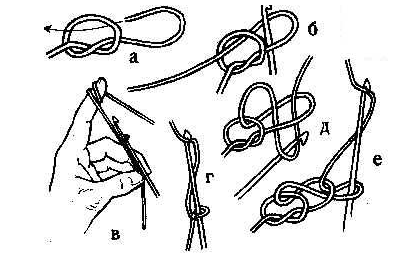
Rugs made from bags can not only be knitted. A good option would be a composition from fluffy balls, which can also be made from scrap materials - for example, garbage plastic bags. The main thing is that the bags have a soft structure. In addition to the usual functionality of the mat, you can build a massage mat.
To work with your own hands you need to prepare:
- plastic tapes from bags;
- two small rectangular cardboards;
- strong threads;
- scissors.
The pompoms will be attached to the backing. It should be strong enough if the rug will be walked on frequently, for example, if it is placed in a hallway. You can use a regular mosquito net - its advantage is that after trimming you do not have to stitch the edges.
Pompoms can be made different methods. For the simplest of them, you will need two thick cardboards or two rectangular pieces of plastic; they will act as templates. The width of the rectangles will be equal to the radius of the polyethylene elements of the mat. DIY work includes the following steps:
Preparation of the workpiece. Cardboard rectangles are placed on top of each other, and a strong thread is laid between them to tie the polyethylene strips together. The length of the thread should be such as to not only tie the ribbons, but also attach the resulting pompom to the backing.

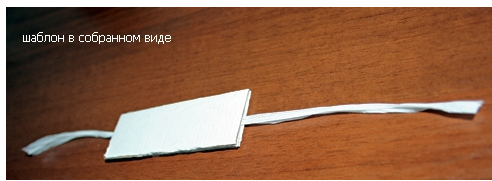
You should wind it carefully so that the turns lie close to each other. This first tape will hold the cardboard rectangles together and secure the thread between them. You can choose any width of the strip, optimally within 10-15 mm.
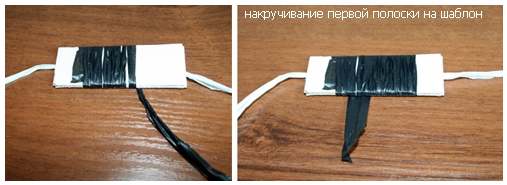
The remaining tapes are wound on top of the first, their number is selected based on the planned density of the polyethylene pile. The quantity depends on both the size of the tape and the density of the packages. It is best to select this parameter experimentally.
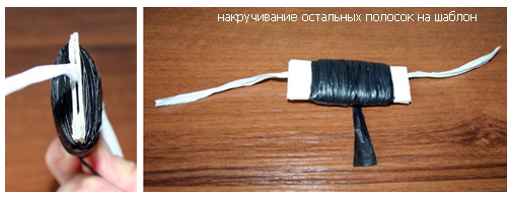
After winding all the strips, the ends of the thread are tied to each other on one side of the workpiece, and on the other side the strips are cut. After this, the cardboards are removed.
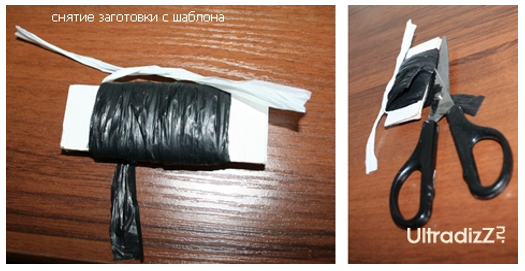
The thread is pulled tightly and the cut ribbons fluff up. When you get a spherical shape, the pompom can be considered ready.
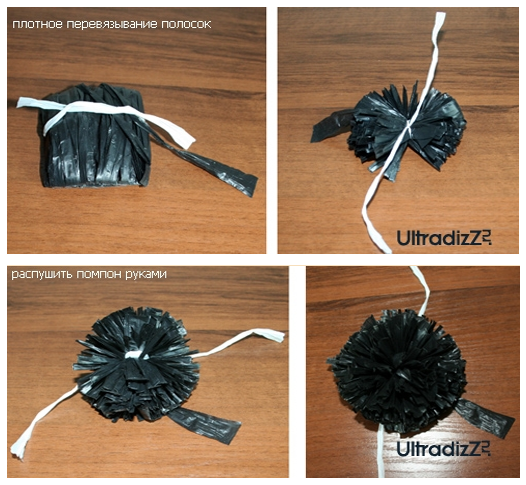
Having made a sufficient number of these balls with your own hands, you can tie them to the substrate in any pattern.

It is worth noting that such a carpet is not intended for heavy traffic, since under the influence of mechanical loads large pom-poms are easily detached from the backing. You can get rid of this by experimenting with the thickness of the base and the diameters of the polyethylene balls. Smaller pom poms will eliminate most problems.

